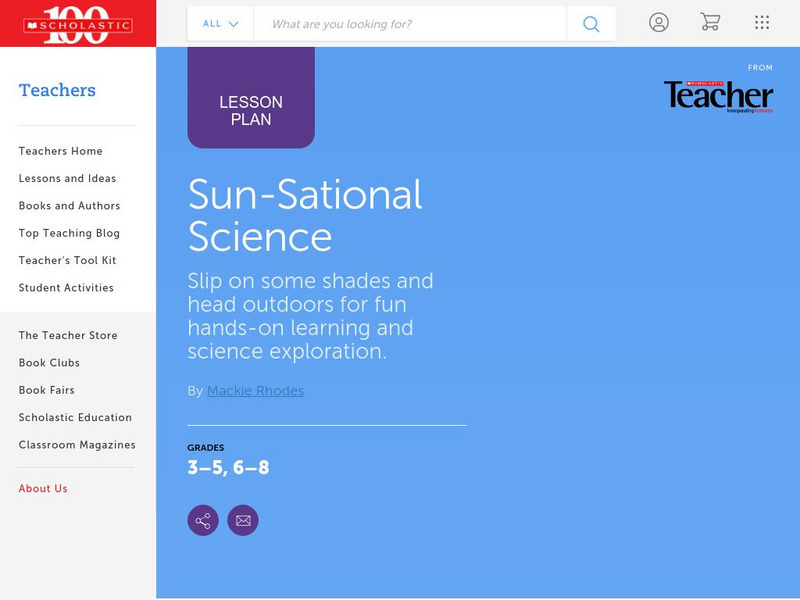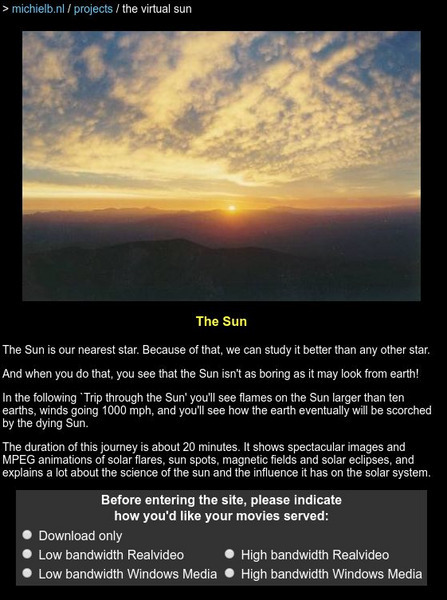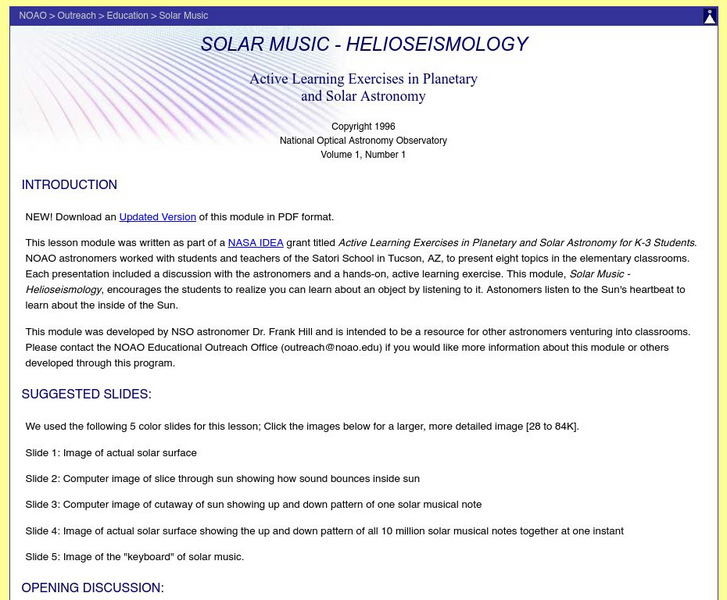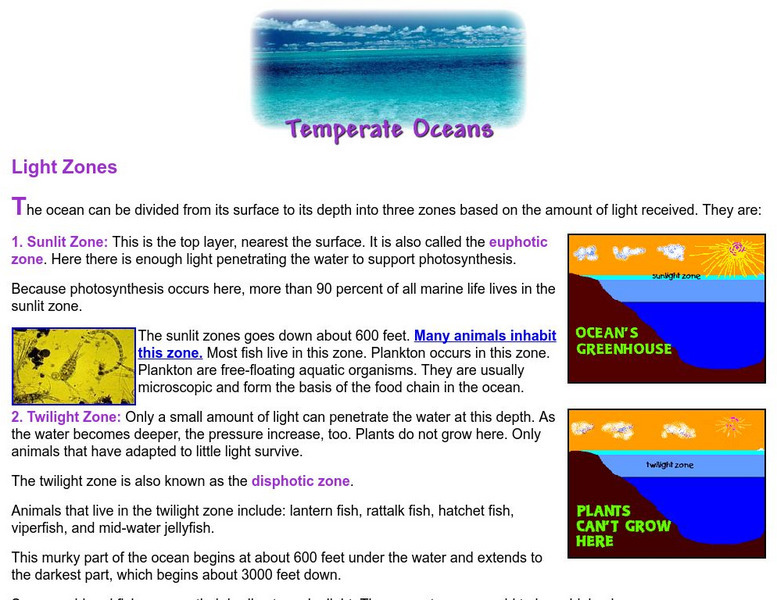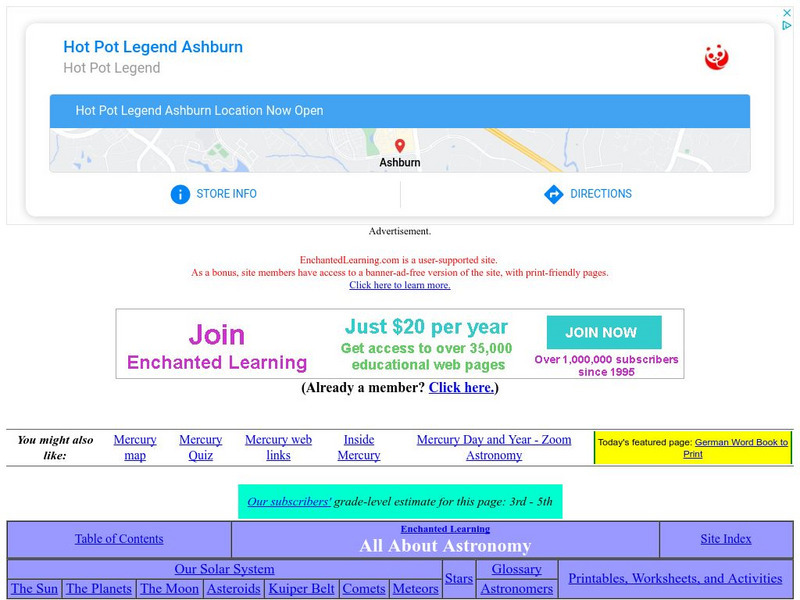Hi, what do you want to do?
Curated OER
Solar Lesson
First graders complete sunlight and solar effects activities to learn about light and its power. In this solar activity lesson plan, 1st graders complete a sunscreen test activity, a light test, a black light test, a cloudy test, a...
Curated OER
Gases Around Us
Students participate in an online lesson showing that gases are formed when liquids evaporate and that when a gas is cooled, it condenses to form a liquid, and gases move and flow more easily than liquids, and how gases differ from solids.
Curated OER
Micro-organisms
Students examine how micro-organisms are living organisms that are often too small to be seen. They explain that micro-organisms may be beneficial or harmful.
Curated OER
Hurricane Scavenger Hunt
Fourth graders use Internet and/or library resources to locate and record information about hurricanes on a worksheet..
PBS
Pbs Learning Media: Characteristics of the Sun
This video segment adapted from NASA describes the basic characteristics of our star, the Sun. Includes background reading material and discussion questions. Video length: 1 min. 28 sec.
Nine Planets
The Nine Planets: The Sun Facts
Statistical data, general features, key terms, characteristics, and influences of the sun.
Exploratorium
Exploratorium: Science Snacks: Reflections of a Star
This simple lesson allows students to work cooperatively in determining the angular diameter of the Sun.
NASA
Nasa: Space Place: What's the Sun's Mood Today?
Find out about characteristics of our solar system's main source of energy, the sun.
Georgia Department of Education
Ga Virtual Learning: Contemporary Literature: Contemporary Drama
This introduction to contemporary drama focuses on the elements or characteristics of drama and the theme of the American Dream. It features the play A Raisin in the Sun by Lorraine Hansberry, which is set in the 1950s.
NASA
Nasa Star Child: The Sun
Get to know our nearest star with this introduction to the sun. Listen to the information in an audio file. Vocabulary words are linked to a glossary of terms. Features include links to other interesting facts and a printable version of...
A-Z Animals
A Z Animals: Animal Facts: Sun Bear (Helarctos Malayanus)
This entry identifies the defining characteristics of the Helarctos Malayanus, more commonly known as the Sun Bear.
Scholastic
Scholastic Instructor: Sun Sational Science
Discover more about the sun when you visit this educational resource. The content of this site includes solar fun facts, experiments, and activities.
Other
The Virtual Sun
This site features a virtual tour of the sun. Expect to learn facts concerning the sun's characteristics, influences, and lifespan with excellent illustrations and multi-media.
Other
Solar Music Helioseismology
This lesson plan demonstrates how to gather knowledge about an object (the Sun) using our sense of hearing. This lesson is designed for grade levels K-3.
TeachEngineering
Teach Engineering: Photovoltaic Efficiency
Through a series of four lessons, students are introduced to many factors that affect the power output of photovoltaic (PV) solar panels. Factors such as the angle of the sun, temperature of the panels, specific circuit characteristics,...
American Geosciences Institute
American Geosciences Institute: Astronomy
Eight hands-on lessons module in which students explore the characteristics of planet Earth, its moons, the sun, the solar system, planets, and the difference between science fact and science fiction.
American Institute of Biological Sciences
Action Bioscience: Looking for Life on Mars and Beyond
Learn some of the characteristics of Mars. These characteristics lead some people to believe that life forms may be found on the fourth planet from the Sun.
Science Struck
Science Struck: A Scientific Explanation to What Causes Day and Night
Explains how the rotation and the axial tilt of the Earth are responsible for the phenomenon of day and night. Provides information about the Sun, the solar system, and the Earth, and how the circumference of the Earth was first measured...
TeachEngineering
Teach Engineering: Mercury and Venus
Students explore Mercury and Venus, the first and second planets nearest the Sun. They learn about the planets' characteristics, including their differences from Earth. Students also learn how engineers are involved in the study of...
Exploratorium
Exploratorium: Solar Max 2000
Examines the solar maximum cycle that occurred in the year 2000. Describes the characteristics of sunspots, solar flares, and coronal mass ejections, using video, photographs, news reports, and similar resources.
Missouri Botanical Garden
Missouri Botanical Garden: Temperate Oceans Light Zones
Discover the three zones in the ocean which are determined by the amount of light received from the sun. Pictures illustrate the three zones and there is a listing of the animals that live in each zone.
Other
Abc Da Energia
ABC Da Energia describes the many ways that energy can be obtained and conserved. It explains different sources of energy, how each works, and how energy can be saved in our daily lives. Interactive energy-saving activities and games...
NASA
Nasa: Weather
Though we live on the surface of the Earth, we actually live at the bottom of an ocean of air. Dynamic layers of air interact with the Earth's surface and the Sun's energy to produce the phenomenon of weather. The atmosphere is...
Enchanted Learning
Enchanted Learning: All About Space: Mercury
The planet Mercury is profiled with information about its size, mass, atmosphere, length of day, and the like. Features include interactive activities and learning exercises.















